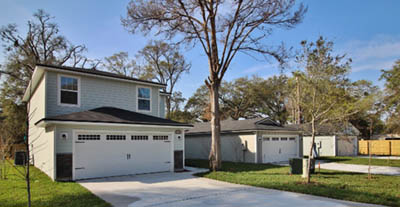Built on an abandoned site, the Southside Oaks Subdivision in Jacksonville, FL now boasts a new community of attractive and affordable homes. It’s a prime example of infill development, a process that is helping aging communities thrive and prosper.
“Filling In” and Revitalizing
As our urban neighborhoods age, vacant or under-used parcels of land—abandoned buildings, overgrown parks, decaying roads—can spoil a neighborhood for its residents. The process of re-developing such property is called infill development. The National League of Cities’ Sustainable Cities Institute uses a synonymous term, “urban infill,” meaning that the property being developed is “filling in” the gaps.
Imagine an urban neighborhood with a bank, gas station, pharmacy, grocery store, apartment buildings, and homes. In the middle of that neighborhood is a large abandoned dry cleaner, a property that has been corroding and derelict for 20 years. That property needs to be developed, or “infilled” to make the rest of the community vibrant again.
Increased Demand for Urban Development
In its Smart Growth publication, the Environmental Protection Agency (EPA) shows how aging baby boomers, millennials, and singles are seeking urban settings that are easy to walk, bike, use transit, or drive shorter distances. Two-thirds of millennials, according to the EPA resource, desire walkable communities where they can use public transit. Singles and retirees are looking for the connectivity that downtown areas offer.
Infill development can help an urban community restore its former vitality by removing the blight of abandoned or vacant properties. It also reduces development pressure on outlying areas, protecting areas reserved for ecological purposes. Moreover, infill development typically results in more non-vehicular forms of transportation being utilized. With less people driving, air quality improves and greenhouse gases are reduced. It’s a win-win for municipalities, residents, businesses, and the environment.
Taking Advantage of Existing Infrastructure
“Infill development allows developers to take advantage of existing infrastructure,” says GAI Florida Market Initiatives Director Nick Mousa, AICP. “Having roads, utilities, and stormwater management in place is a big advantage to an urban development project.”
“Infill development allows developers to take advantage of existing infrastructure.”
By focusing on already developed areas, particularly in urban settings, developers can utilize existing infrastructure and reduce urban sprawl. “There is also a socioeconomic benefit,” says Mousa. “An infill development project such as new housing that attracts young families can help underperforming schools with low enrollment numbers. With a new population of students in the area, schools, parks, even Little Leagues can be revitalized.”
GAI knows firsthand the benefits of infill development projects, making a considerable impact with its work on the Southside Oaks subdivision project in Jacksonville, Florida. “I recently led the Southside Oaks project,” says Mousa. “The project was on an abandoned trailer park and its roads needed to be brought up to standard. GAI played a critical role in the development of that project from concept through construction.”
Southside Oaks: A Classic Infill Development Project

When JWB Real Estate Capital (JWB) purchased an abandoned mobile home property, it was unusable and unsafe. Trash-ridden with crumbling roads, overgrown ditches, and busted streetlights, the site had seen better days.
Today that 14.8 acre property is a model example of infill development. A thriving 99-lot single family subdivision, the Southside Oaks Subdivision boasts affordable and quality homes in an attractive and safe setting.
GAI was retained by JWB to design and permit improvements to the road, utility, and stormwater management infrastructure for Southside Oaks. Providing professional services from due diligence through construction administration, GAI also coordinated permitting with four different jurisdictional agencies. Additionally, GAI assisted JWB in leveraging development rights associated with the lots of record that comprised the site in order to minimize time and project costs.
Overall, the Southside Oaks project makes a good case for the paybacks of infill development. “Each infill development project has its inherent set of challenges and opportunities,” says Mousa. “But all the benefits—revitalization, increased property tax base, ecological preservation, infrastructure in place, socioeconomic—far outweigh the challenges. GAI has a team of experts in all the necessary technical areas ready to assist developers to make these projects a reality.”
For more information about infill development processes, projects, and trends, contact GAI Florida Market Initiatives Director Nick Mousa at 904.559.8133.
For related information, check out the following articles:
Brownfields: Recycling Our Past | August 29, 2012
Some Say Life Begins at 65 – Planning for our Aging Population (Part I) | January 12, 2016
Increased Longevity – Planning for Our Aging Population (Part II) | January 21, 2016
Breathing Life Back into the Historic Town of Eatonville | September 22, 2016
“OBT Next” – Looking Toward the Future | December 1, 2016
Power to the Pedestrian: Road Diets for Walk Friendly Cities | April 27, 2017


